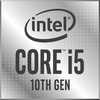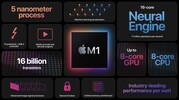Intel Core i5-10310Y vs Apple M1 vs Intel Pentium Gold 6500Y
Intel Core i5-10310Y
► remove from comparison
The Intel Core i5-10310Y is a extremely power efficient quad-core SoC for small laptops and tablets based on the Comet Lake (CML-Y) generation and was announced in August 2019. Compared to the similar Amber Lake processors (e.g. Core i7-8500Y), the only difference are two additional cores in the top models (except i3-10110Y). The processor cores are clocked between 1.1 and 4.1 GHz (all 4 cores 2.8 GHz max). Thanks to HyperThreading 8 threads can be used. Compared to the faster i7-10510Y, the level 3 cache is reduced to 6 MB and the clock rates are lower.
More information on Comet Lake and all the models and articles on it can be found here.
Performance
While we have not tested a single system built around the 10310Y as of August 2023, it's realistic to expect the chip to be about half as fast as the Core i5-10210U (Comet Lake, 4 cores, 8 threads, up to 4.2 GHz) in multi-thread workloads. Those 4 cores of the 10310Y are set to be very much constrained by the low TDP target leading to high DPC latencies and generally unresponsive system behaviour no matter the activity.
The integrated graphics adapter is still the same as in the previous generations. It should be still called Intel UHD Graphics 615 and clock from 300 - 1050 MHz in the i5. Furthermore, the SoC integrates a VP9 and H.265 de- and encoder.
The chip is now produced in the 14nm++ process (Amber Lake Y was 14nm+) but not 10nm like Ice Lake Y. The TDP is specified at 7 Watts but can be varied from 5.5 to 9 Watt from the manufacturer (cTDP up/down) resulting in different performance (especially Turbo durations).
Apple M1
► remove from comparison
The Apple M1 is a System on a Chip (SoC) from Apple that is found in the late 2020 MacBook Air, MacBook Pro 13, and Mac Mini. It offers 8 cores divided in four performance cores and four power-efficiency cores. The big cores offer 192 KB instruction cache, 128 KB data cache, and 12 MB shared L2 cache. According to Apple the performance of these cores should be better than anything on the market (in late 2020). The four efficiency cores are a lot smaller and offer only 128 KB instruction cache, 64 KB data cache, and 4 MB shared cache. The efficiency cores (E cluster) clock with 600 - 2064 MHz, the performance cores (P cluster) with 600 - 3204 MHz.
The M1 is available in two TDP variants, a passive cooled 10 Watt variant for the MacBook Air and an active cooled faster variant for the MacBook Pro 13 and Mac Mini. Those should offer a better-sustained performance according to Apple.
The integrated graphics card in the M1 offers 8 cores (7 cores in the entry MacBook Air) and a peak performance of 2.6 teraflops. Apple claims that it is faster than any other iGPU at the time of announcement.
Furthermore, the SoC integrates a fast 16 core neural engine with a peak performance of 11 TOPS (for AI hardware acceleration), a secure enclave (e.g., for encryption), a unified memory architecture, Thunderbolt / USB 4 controller, an ISP, and media de- and encoders.
The Apple M1 includes 16 billion transistors (up from the 10 billion of the A12Z Bionic and therefore double the amount of a Tiger Lake-U chip like the i7-1185G7) and is manufactured in 5nm at TSMC.
Intel Pentium Gold 6500Y
► remove from comparison
The Intel Pentium Gold 6500Y is an energy-efficient, dual-core SoC designed for use in Windows tablets and passively cooled laptops. The Pentium is based on the old Amber Lake architecture that was initially introduced in 2018. The CPU was unveiled in Q1 2021; it is, in fact, not very different from Intel Core m3-8100Y, the only difference between the two being the slightly slower iGPU model (23 EU UHD Graphics 615 vs 24 EU UHD Graphics 615).
The two CPU cores run at 1.1 GHz to 3.4 GHz and are Hyper-Threading-enabled for 4 processing threads in total.
Architecture
Amber Lake family products are not known to have many improvements compared to the previous Kaby Lake and Skylake processors. They all share nearly the same per-MHz performance and nearly the same set of capabilities. Amber Lake processors do, however, have slightly higher clock speeds in comparison to their immediate predecessors.
Pentium 6500Y has a built-in dual-channel DDR3L-1600/LPDDR3-1866 memory controller as well as several PCI-Express 3.0 lanes for connecting graphics cards, SSDs and other devices. Four PCI-Express 3.0 lanes allow for read/write rates of up to 3.9 GB/s, provided a suitably fast NVMe SSD is used.
Please note this is not a user-replaceable CPU. It is supposed to get soldered permanently on to the motherboard (BGA1515 socket interface).
Performance
While we have not tested a single system built around the 6500Y as of August 2023, we have tested at least one laptop featuring the Core i3-10100Y, a chip that's just a little faster (Amber Lake, 2 cores, 4 threads, up to 3.9 GHz). Based on that, we expect the 6500Y to trail behind the AMD 3020e and the AMD 3050e just slightly. In other words, this is a very slow chip, as of mid 2023.
Graphics
The Intel UHD Graphics 615 normally has 24 Execution Units at its disposal but, for reason unbeknownst to us, just 23 EUs are active in the case of this Pentium. The graphics adapter is not much different from the HD Graphics 615 as found in 7th Gen Y-class Intel Core processors. As such, it has no support for SUHD 4320p monitors, nor can it HW-decode AV1, the latest video codec. Just the more usual VP9, AVC and HEVC are supported.
The UHD Graphics runs at 300 MHz to 900 MHz. This is not a GPU that a gamer would be happy with; very poor 3D performance is to be expected because of the thermal constraints (both Core m3-8100Y and Pentium 6500Y were created with thin tablets and ultra-thin laptops in mind) as well as the rather low TDP of the SoC. Most games will not be playable even if set to Lowest quality preset at 720p resolution. The least graphically intensive titles, like Farming Simulator 19, will pose no problem for the iGPU, though.
Power consumption
The chip is manufactured on one of the old 14 nm Intel processes for fairly unimpressive, as of late 2022, energy efficiency.
The Pentium 6500Y has a default TDP of 5 W (also known as the long-term power limit), half a watt higher than its immediate predecessors; despite the difference, a value this low makes the Pentium more than suitable for use in ultra-thin, passively cooled laptops, tablets, mini-PCs. The default TDP can be reduced slightly (with 3.5 W being the lowest Intel-recommended value) or increased (up to 7 W are possible) by laptop makers if needed, with clock speeds and performance changing accordingly as a result.
| Model | Intel Core i5-10310Y | Apple M1 | Intel Pentium Gold 6500Y | ||||||||||||||||||||||||||||||||||||||||||||||||||||||||||||||||||||||||||||||||||||||||
| Series | Intel Amber Lake | Apple Apple M-Series | Intel Amber Lake | ||||||||||||||||||||||||||||||||||||||||||||||||||||||||||||||||||||||||||||||||||||||||
| Codename | Amber Lake-Y | Amber Lake-Y | |||||||||||||||||||||||||||||||||||||||||||||||||||||||||||||||||||||||||||||||||||||||||
| Series: Amber Lake Amber Lake-Y |
|
|
| ||||||||||||||||||||||||||||||||||||||||||||||||||||||||||||||||||||||||||||||||||||||||
| Clock | 1100 - 4100 MHz | 2064 - 3220 MHz | 1100 - 3400 MHz | ||||||||||||||||||||||||||||||||||||||||||||||||||||||||||||||||||||||||||||||||||||||||
| L1 Cache | 128 KB | 2 MB | 128 KB | ||||||||||||||||||||||||||||||||||||||||||||||||||||||||||||||||||||||||||||||||||||||||
| L2 Cache | 512 KB | 16 MB | 512 KB | ||||||||||||||||||||||||||||||||||||||||||||||||||||||||||||||||||||||||||||||||||||||||
| L3 Cache | 6 MB | 8 MB | 4 MB | ||||||||||||||||||||||||||||||||||||||||||||||||||||||||||||||||||||||||||||||||||||||||
| Cores / Threads | 4 / 8 | 8 / 8 | 2 / 4 | ||||||||||||||||||||||||||||||||||||||||||||||||||||||||||||||||||||||||||||||||||||||||
| TDP | 7 Watt | 5 Watt | |||||||||||||||||||||||||||||||||||||||||||||||||||||||||||||||||||||||||||||||||||||||||
| Technology | 14 nm | 5 nm | 14 nm | ||||||||||||||||||||||||||||||||||||||||||||||||||||||||||||||||||||||||||||||||||||||||
| max. Temp. | 100 °C | 100 °C | |||||||||||||||||||||||||||||||||||||||||||||||||||||||||||||||||||||||||||||||||||||||||
| Socket | BGA1377 | ||||||||||||||||||||||||||||||||||||||||||||||||||||||||||||||||||||||||||||||||||||||||||
| Features | DDR3L-1600/LPDDR3-2133 RAM, PCIe 3, 4 GT/s bus, vPro, MMX, SSE, SSE2, SSE3, SSSE3, SSE4.1, SSE4.2, AVX, AVX2, BMI2, ABM, FMA, ADX, VMX, SMEP, SMAP, MPX, EIST, TM1, TM2, Hyper-Threading, Turbo, SST, AES-NI, RDRAND, RDSEED, SGX | ARMv8 Instruction Set | DDR3L-1600/LPDDR3-1866 RAM, PCIe 3, 4 GT/s bus, MMX, SSE, SSE2, SSE3, SSSE3, SSE4.1, SSE4.2, AVX, AVX2, BMI2, ABM, FMA, ADX, VMX, SMEP, SMAP, MPX, EIST, TM1, TM2, Hyper-Threading, Turbo, SST, AES-NI, RDRAND, RDSEED, SGX | ||||||||||||||||||||||||||||||||||||||||||||||||||||||||||||||||||||||||||||||||||||||||
| iGPU | Intel UHD Graphics 615 (300 - 1050 MHz) | Apple M1 8-Core GPU | Intel UHD Graphics 615 (300 - 900 MHz) | ||||||||||||||||||||||||||||||||||||||||||||||||||||||||||||||||||||||||||||||||||||||||
| Architecture | x86 | ARM | x86 | ||||||||||||||||||||||||||||||||||||||||||||||||||||||||||||||||||||||||||||||||||||||||
| Announced | |||||||||||||||||||||||||||||||||||||||||||||||||||||||||||||||||||||||||||||||||||||||||||
| Manufacturer | ark.intel.com | ark.intel.com | |||||||||||||||||||||||||||||||||||||||||||||||||||||||||||||||||||||||||||||||||||||||||
| Transistors | 16000 Million |


 Deutsch
Deutsch English
English Español
Español Français
Français Italiano
Italiano Nederlands
Nederlands Polski
Polski Português
Português Русский
Русский Türkçe
Türkçe Svenska
Svenska Chinese
Chinese Magyar
Magyar
